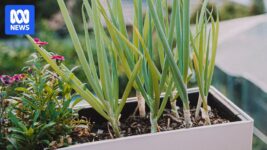
The herbs and edible plants you can plant once and keep enjoying
It’s hard to beat fresh herbs straight from the garden, especially when you’re not having to pay for a huge bunch when you only need a few leaves.
Many herbs are seasonal, meaning they only last a short time and require replanting if you want an ongoing supply.
But there are some great perennial herbs and edible plants — ones that last at least two years, but many much longer — that require minimal effort to grow and have on hand for your cooking.
It’s worth checking which of these plants suit your location before planting, as some will do better in certain climates.
Suitable for renters and small spaces
Passionate urban gardener Connie Cao lives in Naarm/Melbourne and eats veggies and herbs almost entirely from her own garden.
She says spring is a good time to start establishing your own herb collection and spring onions are “a super easy way to start as a beginner gardener”.
“Once you buy spring onions once … you pretty much never have to buy [them] again,” she says.
Connie Cao says mint can become invasive if you don’t confine it to a pot. ( Supplied: Connie Cao)
Connie grew hers from a supermarket bunch — cutting off the tops (or green parts) and planting the roots in a small pot about three to five centimetres apart.
She says she has found varieties of mint easy to grow, but given its tendency to sucker and spread, it can be helpful to keep mint contained in pots.
Because it grows from runners, Connie suggests if you know someone who already has some growing, they’ll “likely be very happy to share”.
She says hers tends to “die down” in the heat of summer but will “pop back up again”. And while the plant is perennial, cutting back and repotting is beneficial.
Connie Cao says homegrown lemongrass ‘smells so fresh and fragrant’. (Supplied: Connie Cao)
Connie says she has also found lemongrass simple to grow in a pot at home and that hers “pretty much thrives on neglect”.
Lemongrass is a tropical plant that’s easier to grow in warmer climates and sensitive to frost. Growing plants like this in pots allows you to move them to frost-free areas if you need to.
Community Gardens Australia volunteer Fiona Campbell was a sustainability educator for a Sydney Council. She now lives in Tasmania/lutruwita and says planting in pots is a great option for those short on space.
She says chives, sage, oregano, marjoram and sage are all perennial herbs that can thrive in pots and are “quite expensive” to buy in the supermarket.
Best for bigger pots or spaces
Ms Campbell says rosemary would benefit from a larger pot or space.
Connie Cao also grows yuzu in a large pot. (Supplied: Connie Cao)
Connie adds rosemary requires regular harvesting or trimming back to keep it “bushy and compact”. The good news is you can use the cuttings to grow more.
But she thinks it’s another good option for beginner gardeners.
Ms Campbell, says bay trees are also suited to a big pot and you can pick the leaves as needed.
She recommends not planting them in the ground, as bay trees can produce new shoots from their roots.
With a little extra space and time
Ms Campbell says asparagus “needs a lot of room” — like a garden bed — but is also perennial.
She says it takes two to three years to establish before you can harvest asparagus spears, but after that you can harvest them annually during spring. She recommends regularly topping up the soil with compost for asparagus.
Fiona Campbell in her low-maintenance, perennial garden bed. (Supplied: Russ Grayson)
She says for those with a “bit of space” rhubarb and leafy french sorrel are also an option.
Ms Campbell says growing the “bright green of the sorrel and the darker big leaves of the rhubarb” together creates a layering effect visually in a garden.
She says rhubarb might need “freshening up” every three to five years if it begins to look “ratty”. When this happens, Ms Campbell says she divides up the plants and replants them in another bed.



